
-First in a series-
Story and photos by Donald H. Harrison

TECATE, Mexico — Unlike some Mexican cities along the U.S. border, such as Juarez, or Tijuana, where there have been outbreaks of violence between rival drug gangs, or between law enforcement officials and drug lords, Tecate is a quiet town which derives much of its income from three quite stable industries: the Shlage factory which assembles locks, the Tecate brewery which makes beer, and the 3,000-acre, 400-employee Rancho La Puerta, which for 72 years has been providing guests an opportunity to disconnect from urban tensions and nuisances, and to live in harmony with the landscape and their bodies.
Although one can drive a private automobile to Tecate from San Diego in about an hour, Nancy and I recently decided to begin and end our week-long stay at Rancho La Puerta (Ranch of the Door), by taking advantage of the air-conditioned Sundance Stage Line service provided by Rancho La Puerta from Lindbergh Field, San Diego’s International Airport. Once we were aboard the coach, our step-on guide, Jeovanna, distributed to us a portfolio of materials outlining the week’s activities at the ranch, some water, and even a small packet of home-made granola mix to munch on as we watched San Diego County’s rural countryside along State Route 94 slip past us as we proceeded to Tecate.
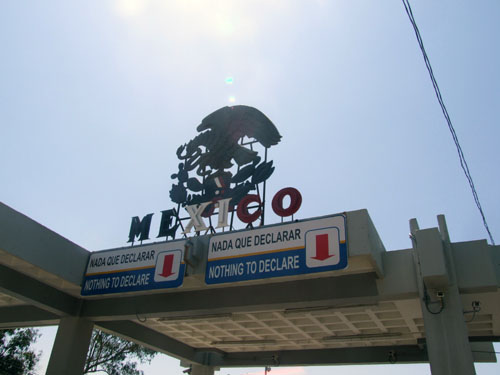
Before we arrived at the international border, Jeovanna distributed the required Mexican immigration forms, and instructed us in how to fill them out. She also explained the cross-border procedures, which include payment of a $30 tourist fee for people who plan to stay in Mexico for more than a week. She then collected our forms and our passports, and while we walked across the border and porters marshaled our luggage, she handled the formalities. On the other side of the border, vans were waiting for us for the 3.5 mile drive to Rancho La Puerta, all going like clockwork. A week later, the return home followed the same procedure in reverse.
Ranch La Puerta personnel, many of whom were educated in the United States, awaited us with cool drinks, fruit plates and personalized, plastic Rancho La Puerta water bottles. While we were efficiently given our room assignments, we noted the Administration Building’s carved doors and stained glass windows by artist James Hubbell, as well as indoor and outdoor sculptures by various artists set along meandering paths landscaped with native and eco-equivalent plants that flourish in areas with climates similar to the countries of the Mediterranean.
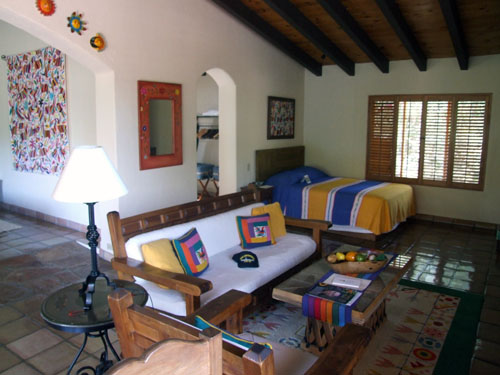
These paths lead to a wide variety of activity areas, as well as to private little houses or “casitas,” each of which is tastefully decorated with examples of folk art collected from various regions of Mexico.
At the heart of the ranch are a variety of exercise and sports areas including four swimming pools, tennis courts, volleyball court, and seven gyms, with names reflecting the ethnography and botany of Mexico: Maya, Kuchumaa, Olmeca, Pine Tree, Arroyo, Montaña, and Tolteca. Here one may participate in an alphabet of healthful and intriguingly named activities: Abs and Cycle; Balance and Coordination; Bioconstruction; Body Bar Tabata; Cardio Drum Dance; Chanting; Circuit Training; Cranialsacral Therapy; Crystal Bowl Sound Healing; Dance; Feldenkrais; Foam Roller; Gardening; Hike; Hydro Fit Water Training; Inner Journey; Juice Fasting; Meditation; Pilates; Pool Pilates; Postural Therapy; Release and Mobilize; Sculpt and Strengthen; Stretch; Tai Chi; Tennis; Treadmill Trekking; Tri Core Workout; Volleyball; Water Polo; Weight Room and Yoga.
Joe Sweeney, bird watcher-in-chief, bingo caller and ranch emcee, urges guests not to exercise to excess, but rather to be moderate in their workout schedules. “A good strategy is to follow a hard day of exercise with an easy day of exercise, varying the intensity from day to day.”
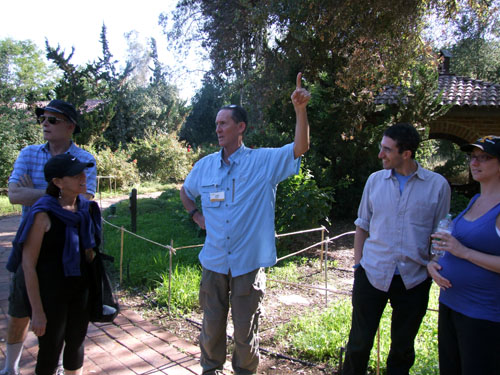
There are more “restful” organized activities on the ranch, among them: bird watching, ranch tours, nightly movies, lectures by a variety of experts; guitar concerts; yarn painting; Spanish lessons; art walks; cooking classes; jewelry making; nutrition discussions; walking through a labyrinth; and bingo. For those who desire private activities, there are walks along meandering paths, a library filled with interesting books, hammocks for naps, pools for soaking; and health centers for massage, manicure and pedicure treatments.
With so many activities, punctuated by three principally vegetarian meals a day (supplemented with eggs, dairy and fish), the days of the week pass by quickly.
*
Edmond Bordeaux Szekely, who founded Rancho La Puerta in 1940 as the Essene School of Life, made much of the fact that the climate in Tecate was similar to that of the Galilee where Jesus lived and preached. Of Jewish heritage and a practitioner of Unitarianism, Szekely was eclectic in his religious outlook, equally at home with ideas of Eastern and Western religions, as well as Hellenism. He was an advocate of vegetarianism, exercise, and various body treatments including a course of enemas. He attributed many of his ideas to the writings of the Essenes, who survived in harsh climates around the beginning of the Common Era. Undeterred by critics of his ideas and his academic sources, Szekely, aided by his young wife, attracted a health-conscious following from around the world.
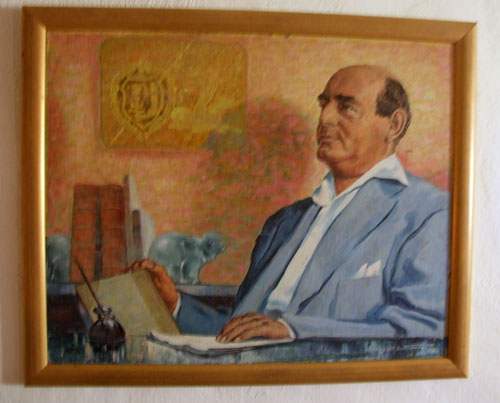
According to his biography, the surname “Szekely” comes from the Szekely region of Transylvania, Romania, where Edmond as a student of philosophy graduated from the University of Kluj. He wrote extensively and traveled around the world as a lecturer about the Essene philosophy, offering summer camps in various locales where people could put his theories on health to practice. Rebecca Shainman, an officer in the vegetarian society of New York, was quite health conscious. With her husband Harry and their daughter Deborah, the family traveled to Tahiti, where they met and became followers of Szekely, who became familiarly known as “the professor.” Thereafter they traveled each summer to his camps, with young Deborah Shainman growing up as a disciple. When Szekely’s longtime English secretary and translator of his books, L. Purcell Weaver, left his employ at the beginning of World War II to take up a post in the Canadian military, Szekely arranged for Deborah to become his secretary. She was 17 and he was 34 but despite their considerable age difference, they were married.
As a citizen of Romania, which was allied with Nazi Germany, he was subject to that country’s military conscription, but as a man of Jewish descent, he was aware that returning to Romania would be foolhardy. He and Deborah decided in 1940 to wait out the war in Mexico, where they were made welcome. Near the small house they rented grew two Live Oak Trees, their branches forming an archway, or a door, and this prompted them to name their camp, Rancho La Puerta. In the ensuing 70 years, Rancho La Puerta was purchased, landscaped, rebuilt, and increased exponentially in size. It changed its format several times, at one time being thought of as a fat farm, at another as a place for nude sunbathing, later as a playground for Hollywood celebrities, and more recently, in what perhaps may be described as a return to its roots, a place of quiet spirituality.
**
The extent of founder Deborah Szekely’s interests can be appreciated in Rancho La Puerta’s small museum, which was the original cottage near the two Live Oaks where the Szekely family first lived. Photographs of her and U.S. Presidents date back to Richard Nixon, but one also can find her with Ronald Reagan, and George H. W. Bush. There are also photographs of her with Bill Clinton, with Hillary Clinton, and with both Clintons. These are displayed with a variety of resolutions and proclamations, including a certificate from Nixon appointing her to the Council on Physical Fitness and Sports; a note from Reagan lauding her for contributions to the U.S. Information Agency and for promoting the American way of life; an award from the local Mexican and American Foundation noting her service as president of the Inter-American Foundation; resolutions congratulating her for various accomplishments from the California State Assembly and from the San Diego City Council, and an honorary doctor of humane letters degree conferred upon her in 2007 by the California State University and College System.
This latter honor–a doctorate–may have been particularly sweet for the self-educated woman, who set out on a course of educational improvement and intellectual development in order to try to keep up with her husband, the professor, whose many books are displayed in the larger back room of the cottage. A sampling of his books, which he printed on a press kept at the ranch, deals with such subjects as the Essene Gospel of Peace, Essene Origins of Christianity; the Teaching of Zarathustra; Man in the Cosmic Ocean; Ludwig Von Beethoven (his favorite composer); Chemistry of Youth; Sexual Harmony; and The Soul of Ancient Mexico.
Behind the cottage are some curiosities from the ranch’s history. One was a small unplumbed “house” made from a crate in which airplane engines had been shipped during World War II; Deborah had acquired 20 of these for $115 each from Camp Lockett, a nearby U.S. Army base, to create more housing during the ranch’s early years. Today the only one left is the museum piece. There also is a shallow brick depression which, when half-filled with water, used to serve as a “Sumerian bath” at the ranch. Guests would lie on their backs half submerged in the sun-heated water for 10 minutes, then on their bellies for another 10 minutes. According to the professor, this treatment would result in an increased pulse rate, and a sped-up metabolism. However, according to information at the museum, “this proved too Spartan to be popular for long.”
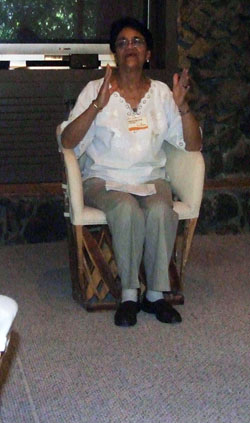
Concierge Manuelita Ching, of mixed Mexican-Chinese parentage, has worked at the ranch since 1962 in a variety of capacities. She recalled the names of many Hollywood celebrities she met at the ranch over her 50 years there, including Burt Lancaster, Kim Novak, Mary Tyler Moore, Peter Lawford, Cicely Tyson, Burl Ives, Barbra Streisand, Sophia Loren, Marlo Thomas, George Hamilton, Steven Segal, Kate Winslet and Julia Roberts.
Just a teenager when she started, she recalled being thrilled when Lancaster’s agent booked a room, with strict orders that it be located in a remote section of the ranch, so he could have privacy. But when Lancaster got there, he used to work out shirtless on the volleyball court, drawing a crowd of admiring guests. In the days prior to computers, appointments were noted on flip charts tacked to the walls of the office, Ching said. As a girl she kept her fingernails very long, and while she was working with the flip chart, Lancaster came in and said, “Look at your fingers, let me see.” When he held her hand, she swooned with girlish delight. Whenever he’d return to the ranch after that, she admitted, she’d wave her fingernails at him, hoping to again catch his eye.
Ching said she used to read all the movie fan magazines, and when actress Kim Novak came, she expected to see a glamour queen. But without make-up and a new hairdo, the actress looked like an ordinary mortal. The concierge also recalled the time that a maid opened the door to Peter Lawford’s casita, and quickly closed it, thinking she saw a critter on the floor, perhaps a tarantula. She called a groundskeeper, and they carefully re-opened the door, using a broom to protect themselves against the thing– which turned out to be absolutely harmless. It was Lawford’s toupee. Ching remembered Lee Majors principally for the late night he brought a mariachi band to a pool area by the villas, awakening fellow guests.
The ranch has attracted celebrities from the political and literary worlds. The author, Aldous Huxley, was a regular. Ching said Secretary of State Madeleine Albright checked in for a vacation during her term of office, and that Gayle Wilson, former first lady of California, and current Gov. Jerry Brown have separately visited the ranch.
Ching said that among the ranch’s most memorable characters was Arturo, last name unknown, the hermit who lived in a cave in the mountain to which ranch guests hike every morning. He would stay in his cave during the day, but befriended by a kitchen worker, would visit the ranch some late evenings, and be treated by the staff to a meal. Sometimes, for the convenience of the guests, he would post on a bulletin board the names of the movies that were playing at the theatre in town. (Today, the ranch rents DVD’s of recent movies, screening one a night.) Eventually Arturo’s family, in Switzerland, learned his whereabouts, and arranged for him to be transported home. But he apparently slipped away at an intermediate stop, and disappeared to who knows where.
Recalling her years growing up on the ranch, Sarah Livia Szekely Brightwood related in an interview that there was a division of responsibility between her parents. Her father Edmond Szekely, the writer and lecturer, offered ideas for health, and was very much the resident teacher and philosopher. Deborah, today semi-retired in San Diego at age 90, was the practical one, who accepted the reservations, supervised the staff, and created new programming in response to requests from guests.
Eventually, the professor and his wife grew apart not only in professional outlook but personally. They divorced. Edmond Szekely set out with his secretary, Norma, upon a course of writing and travel, ending up in Costa Rica, where he died in 1979. Sarah Livia and Alex arranged to bring back his body to the ranch that he founded, and he is buried on the slope of a hill, near the “Eagle’s Nest” cottage, which among other furnishings has a bed, a Menorah with a Star of David base, and a picture of St. Francis hanging on the wall. On the same hillside, a little below, is the grave of Alex, who died in 2002.
Next: An interview with Sarah Livia Szekely Brightwood, president of Rancho La Puerta
*
Harrison, editor of San Diego Jewish World, seeks Jewish-interest stories wherever he goes. His wife Nancy is an agent with Avoya Travel/ American Express, who’ll be happy to answer questions about Rancho La Puerta accommodations and reservations at (800) 786 3265, or (619) 265-2909, or via nancy.harrison@avoyatravel.com
I stumbled over the article searching on “sumerian bath”. I am a follower of Szekley and Kenneth S Jaffreys teachings (Jaffrey studied and corresponded with E. B. Szekley for many years although the two never met). I am pleased to know that Rancho La Puerta is still running and would be delighed to see this place one day!
Eric Karlsson DN ND
http://www.self-healing.eu
Pingback: Rancho La Puerta is a healthy destination | Nancy's Cruise Services
Wonderful, fact-filled article about a remarkable place. I remember when Sheba Penner, wife of Rabbi Samuel Penner of Beth Tefilah Synagogue used to work there. Hal and I once spent a week-end at the ranch, i giving a session on How Strings Work and allowing each person to try their hand on a violin, viola or cello, and Hal giving a talk on foreign language learning.